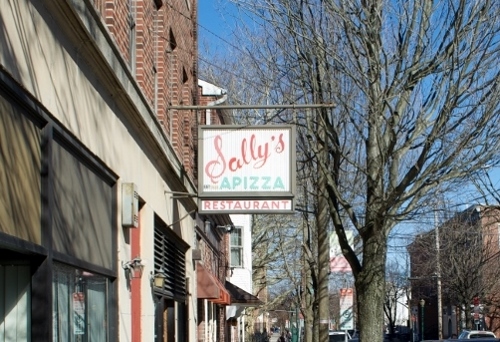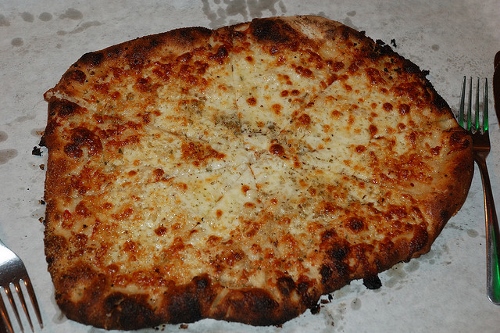Yesterday evening, an email subject line caught my eye: “We’ve discovered the tastiest pizza in New York City!” Three weeks ago, I, like several other New Yorkers, would have translated this statement as meaning “the best pizza in the world”. A few headstrong New York-by-way-of-Chicago-ers would have asserted that this title belongs to deep-dish pizza (in all seriousness though, to all you Windy City locals, your Italian culinary pride and joy is a goddamn casserole, not a pizza). But regardless of what anyone says, the truth is that the best pizza isn’t in either these laces, but in a sleepy town. Specifically, New Haven, Connecticut.
Yes, contrary to our ungrounded formula that Big City equals good pizza, this quasi-podunk New England town of Ivy Leaguers and dive bars is also the birthplace of the best pizza known to man. When my friend Arun moved to New Haven for graduate school, he graced me with the knowledge of New Haven pizza; furthermore, he stated that he hadn’t missed a New York slice since moving. I was almost insulted. Given that this was such a bold claim for any New York-based pizza aficionado, I stole away to visit him one sneezy spring weekend, hoping to also understand the local buzz behind New Haven’s mystic pizza.
On the northbound train ride, I found myself doing culinary mental gymnastics trying to comprehend what sort of flavor-physics could explain the New Haven pie. “Tomatoes? Dough? Certain Cheese?” I quickly resigned to the fact that my efforts were getting me nowhere. Instead, striking up a conversation with a nearby local, I soon received in addition to a list of bars for cheap and fast booze, a two-minute lecture on New Haven Pizza 101.
To my surprise, Gary, the local, was astonishingly versed in his hometown’s pizza tradition, which traditionally is known as “apizza” (pronounced “ah-beetz”). According to the “professor”, the history of New Haven and New York pizzas are interlinked, being two sides of the same Neapolitan pie. Both came about in America via mass Italian immigration in the early 1900s, and both utilize fiery-hot baking temperatures to add char to the crust. And of course, both are beloved by the locals at all hours of the day.
But then the disparities begin. The New York slice is the standard fare and familiar to everyone: a lot of cheese, a little tomato sauce, and a heavy crust whose dough the pizza boys will throw to the sky. New Haven pizza, on the other hand? Not so much. “New Haven pizzas have barely any cheese,” he explained. “It’s just crust, a sizable amount of tomato sauce, and a dusting of cheese. That’s it!” My jaw dropped in shock, and along with it, a gluttonous stretch of drool.

For the duration of my trip in New Haven, I waited for pizza. My anticipation sitting in his dorm room studying for exams built tremendously from Gary’s purple prose of New Haven pizza. I found myself dreaming at night of those greasy slices, drenching themselves in tomato sauce, scrubbing their bods with Parmesan blocks. It was the most hardcore food porn I’ve ever self-induced. Finally, on Sunday, my patience was rewarded with my very own pie of New Haven-style pizza from Sally’s Apizza.
Traversing to the opposite side of I-95 via ZipCar, Arun and I passed by the projects permeating Wooster Street, the Little Italy section of New Haven. Unknowingly, we passed by Frank Pepe Pizzeria Napoletana, which Sally’s co-owner Robert “Bob” Consiglio informed me was the founding institution of the New Haven pie. “My father’s uncle Frank [Pepe] started his pizzeria, and my father [Sal Consiglio] started working there as a young boy.” Unfortunately, even in family business, shit happens. Bob informed me that after several years of working at Frank Pepe’s, a fight erupted between Frank and Sal. Eventually, Sal jumped ship and bought a failing bakery with his mother Flo Consiglio that became Sally’s Pizza, the second of three flagship New Haven-style pizzerias in the town. Since its inception, Wooster Street has been the battlefield for which is the best New Haven-style pizza. (Modern Pizzeria, which also opened up around that time, enjoys New Haven-style authenticity, but it is neither within the Little Italy confines—Modern is located in the East Rock neighborhood—nor is it related to the family. As a result, it also enjoys freedom from this family drama). Nowadays, Sally’s is fighting for the title with Bob and his brother/fellow co-owner Richard at the helm.
By sheer coincidence (and some of Arun’s persuasion), I ended up at Sally’s, going a bit on the adventurous side by ordering a New Haven-original: the White Clam pizza. Its origins are dubious, but Bob claims it was a factor of people just loving oysters (he also admits someone else in the world has probably done the exact same thing). Like a true New Yorker, I originally ordered a slice of pie, but was informed that as with any true New Haven pizza, “there’s a minimum order of eight slices”, or a pie. Although Frank’s attempted a “by-the-slice” process for a brief period of time, true New Haven pizzas are sold by the pie. “It just happened that way,” Bob explained.

Flickr/Carl Lender
Admittedly, I was fortunate. Yelp reviews caution tourists of hour-long waits; our takeout took us all but 10 minutes. Still, it makes you wonder what could drive some, even New Yorkers visiting, to such pizza frenzy wait-time akin to the Ramen Burger. While many claim what New York pizza magic comes from the water (several restaurants around the nation claim to import NY water for their bread) or the high-gluten dough, Bob says it’s neither of these for the New Haven-style. Rather, it’s a simple equation: the thinness of the crust (“Our stuff is so thin, if I tried to toss it I’d be wearing a necklace,” he laughed.) and the coal- oven. The latter is an integral and tedious process, and unfortunately, it’s as hard to learn how to use a coal-fired oven as it is important to the flavor of the pizza. “It takes several months for you to just get a basic hang of coal-based oven roasting, and it takes years to even come close to mastering it,” Bob explained. “I’ve tried replacing a guy we recently lost for the past six months. I’ve already gone through three guys.”

To make sure I wasn’t insane if I wound up dubbing New Haven pizza the best (and possibly worth another trip in the near future), I brought a pie all the way back to New York for a roundtable judgment by four die-hard “Dollar Slice”-ers. After some heavy persuasion to join me in possibly committing blasphemy and a quick oven reheat, we sank our teeth into the greasy goodness. The reaction was unanimous: “OHHHHHH.” Several more of these foodgasm moans soundtracked the remainder of our meal. And by the end, with shame plastered across all of our faces, we all agreed this had possibly been the best pizza we’ve ever had.
So, I concede that Arun was right; New Haven far trumps New York-style pizza. Unlike New York’s moderately thick-crusted, cheese-saturated, unspiced slices, the New Haven-style pizza boasts, well, actual flavor. Pockets of garlic-y umami explode in every bite; the oregano in the sauce infuses its flavor into crust during the baking process, adding a kiss of sweetness, much unlike the hefty amount that I drunkenly douse on my dollar slices. And that little drizzle of olive oil in the topping goes a long way. But the true kicker? The crust.

There’s no way around it; the crust is what puts this pizza on top of every other style. Even the White Clam Pie, which enjoys its own fair share of cheese, trumps the cheese-heavy NY slice. There’s a physics-mastered chewiness to the pie’s base thanks the ultra-thinness, and it is accompanied by a beautiful char that carries with it some lovely smokiness. And all of this is thanks to that beast of a coal-based oven, which can reach temperatures of up to 650 degrees F.

Given the rise of the Internet and the flattening of the world, as well as the undying relationship between Yale University students and the Wooster Street pizzerias, the fame of New Haven-style pizza is spreading. Although not “authentic” in the historical sense, New Haven-style pizza parlors are popping up around America—hell, even around the world. Even Frank Pepe’s has spread beyond the confines of Wooster Street, setting up shop in the Mohegan Sun Casino in Uncasville, Connecticut.
Also, let’s not forget these guys are, well, getting old. “I can’t do this forever,” Bob, who is in his latter 60s, admitted. “My kids have their own professions so they won’t take over afterwards.” Given that he and Richard will, in a near future, be relaxing their positions as owners, it’s clear that companies are approaching Frank and Sally’s for possible cooperation, larger projects and expansion, and while nothing’s been signed yet, it looks like there will soon be a future with several Sally’s locations outside of New Haven. Of course, all of these will still be operated with strict regulations by Bob to match his supremely high—and well-justified—pizza standards. And given all the crappy pizzas out there, it’s safe to say most of us could use some authentic New Haven-style pies in our lives.
So whether you’ve got your own type of pizza that you deem king of the pies or you’re indifferent towards pizza in general as a blasé food, if you ever find yourself near a New Haven-style pizza shop, order yourself a pie. You might just find yourself eating your words.
Matthew Levine is a freelance writer and graduate student at Columbia University. When he’s not cooped up in the library or neighborhood coffee shop, he’s probably blowing any excess cash on craft beer, fancy-shmancy ramen, and live music shows. Twitter: @matthewlevine13.